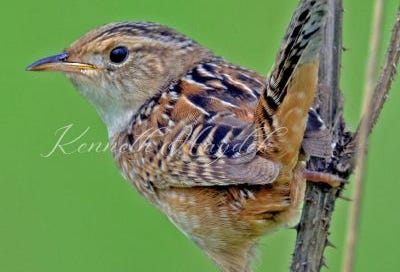August: The Sedge Wren
Meet the secretive sedge wren: a small bird who sure does seem to appreciate a sense of mystery.
During the spring and summer, the sedge wren finds its home among damp sedge meadows, marshy areas, boggy spots, and lush fields in central and eastern United States. (However, it leaves areas populated by reeds and cattails to be inhabited by their relative, the marsh wren.) Being a short- to medium-distance migrant, it winters in the southeastern U.S. or northeastern Mexico.
Sedge wren mysteries begin with their size and coloring. Just four to four-and-a-half inches in size, and having mostly brown-and-black streaky or barred bodies with buffy bellies, sedge wrens blend in well with their surroundings, making their whereabouts something of a mystery to untrained observers. They have long, slender-but-sturdy legs and a medium-length tail, which they flick up and down when agitated.
Sedge wrens have sharp, curved bills which they use to forage for food off the ground or in low-lying vegetation. Diet is also one of the sedge wren’s mysteries in that its favorite food is not well known, but it is thought to eat mostly insects, including crickets, caterpillars, ants, and spiders.
Yet another sedge wren mystery is how it selects its nest. Males build several globe-like nests of woven grasses and sedges with a slim side entryway, and the female—using some criteria we are not privy to—chooses one of the globe nests to make her own, putting on the finishing touches herself by lining the insides with soft hairs, feathers, fur, and plant down.
Males may have more than one mate. Offspring of males with one mate have a higher survival rate, while males with more than one mate have a greater number of offspring to propagate the species. Sedge wrens are aggressively territorial and protective of their nests: both males and females will even pierce the eggs of other birds in nearby nests, including eggs of other sedge wrens, to maintain their space.
The biggest sedge wren mystery of all seems to be why it goes where it goes. Not unlike the dickcissel, sedge wrens are one of the most nomadic territorial North American birds, seemingly unpredictable in their migrations. Colonies of sedge wrens may settle in one spot one summer and then vanish—the reasons for their movements, they keep wholly unto themselves.
If you’re keen to find a sedge wren, you will have to go out looking. Because they breed later than many birds (sometimes nesting in July), you may see some during the declining summer months in wet grassy areas, early in the morning or late in the afternoon. Listen for them closely to key on their location, and survey low fences, bushes, and marshy vegetation to try to solve the mystery of the sedge wren.
Sources:
https://www.allaboutbirds.org/guide/Sedge_Wren/overview
https://ebird.org/species/sedwre1
https://www.audubon.org/field-guide/bird/sedge-wren
https://www.bird-sounds.net/sedge-wren/



